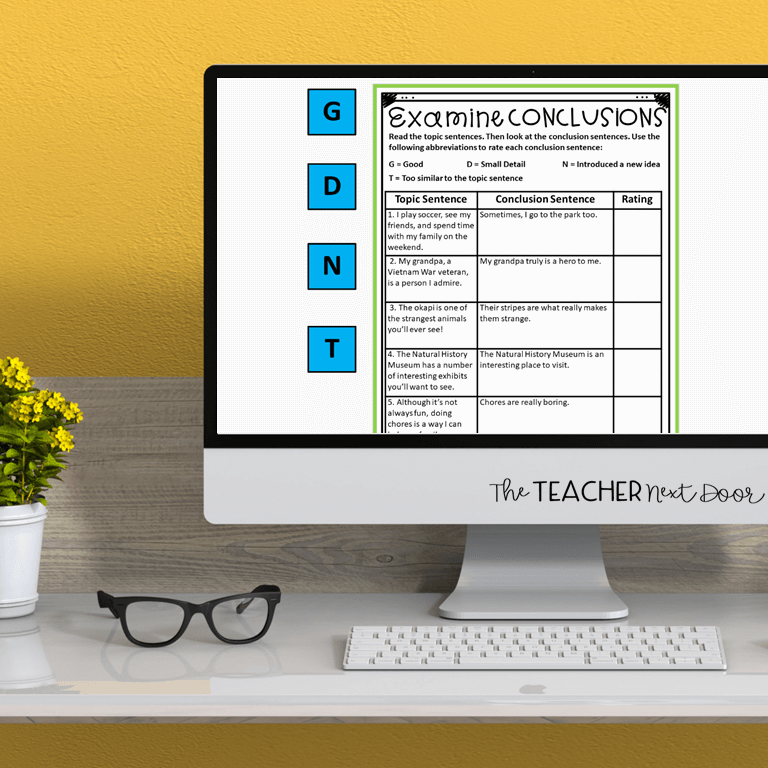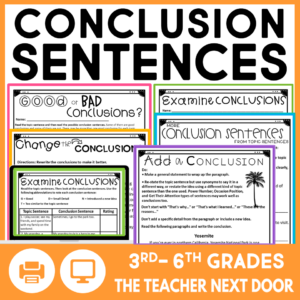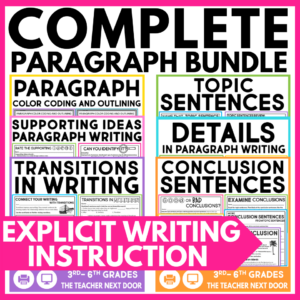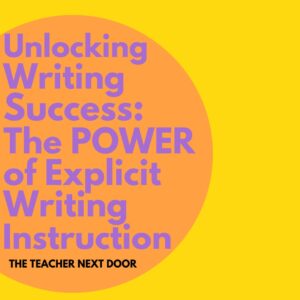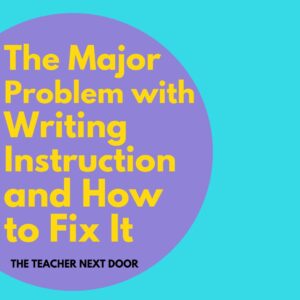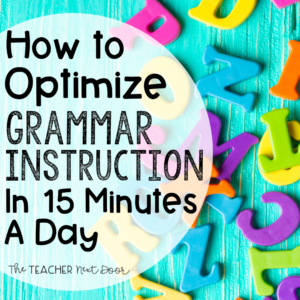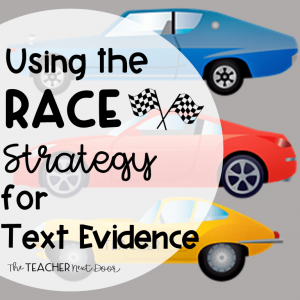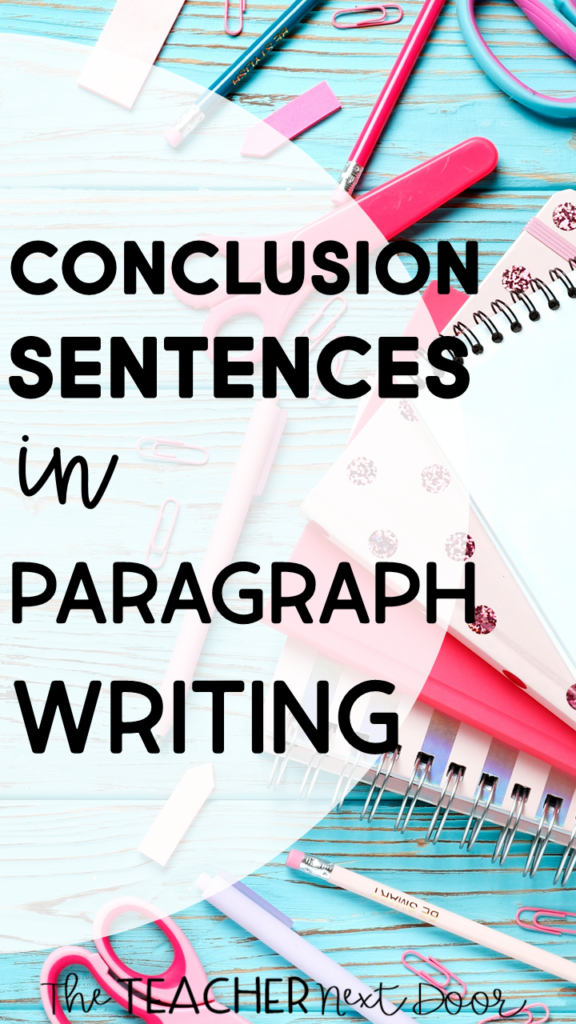
Teaching conclusions is one of the most difficult parts of teaching students to write well-written paragraphs.
Students may be able to write a topic sentence and three supporting ideas with details, but when it comes time to add a conclusion sentence, it’s almost like they’ve run out of steam.
To me, this makes it even more important that as a teacher, I spend a good amount of time specifically explaining how to write conclusions, while scaffolding practice before throwing the little birdies out of the nest.
In this third of a four-part series on Teaching Paragraph Writing, I’ll tell you what has worked for me in my classroom…not promising miracles but hoping you’ll be able to take away something here to make the process a bit easier in your classroom.
Missed the other posts? Here they are if you’d like to read them: Topic Sentences, Supporting Ideas and Details, and Transitions.
1. Explain the Purpose of a Conclusion Sentence
Here’s where we revisit the idea of a conclusion sentence and look at it more in-depth. We talk about why writers use conclusions…mainly to wrap it all up and to give a signal to the reader that the paragraph or essay is ending.
We also talk about what makes a good conclusion vs. what makes a weak or bad one. Strong conclusions are similar to the topic sentence but not TOO similar. Strong conclusions focus on the big idea of the paragraph and NOT on one of the more minor details. Strong conclusions also stay on topic. No new idea is introduced here.
One of the activities I really love doing with my students (and they love it too) is analyzing pre-made conclusion sentences. I put these up on the document projector (no copies for students this first time) and I have students give me a thumbs up or down for each conclusion sentence example. Then we discuss why the example was a good conclusion or not.
This kind of practice is great to help students learn to write conclusion sentences because not only is it non-threatening (way easier than coming up with your own conclusion sentence), it models positive examples while showing students examples to avoid.
On the second day, I hand out a similar worksheet and have students determine (independently or in pairs) if the conclusion is a good one or not. We correct these together and discuss them as we go.
You can sure make up your own conclusion examples if you’d like, but if you’re looking for a print-and-go complete resource for conclusion sentences, I do have one here:
2. Focus on Re-wording the Topic Sentence
One of the ways to make a good conclusion sentence is to reword the topic sentence. We talk about how we can use synonyms and slightly different wording to make the conclusion somewhat similar to the topic sentence but unique enough that it works.
I show students a topic sentence and write it on the SmartBoard if needed. Then I ask them to reword it on whiteboards to make it into a conclusion. This activity helps everyone practice making conclusion sentences. It’s also great for those having trouble, as they’re able to hear other students come up with good examples they might use later.
Once we’ve practiced these, I use some worksheets that are similar to this idea from the conclusions packet and students do independent work with this concept.
3. Use a Different Type of Sentence from the Topic Sentence
When I teach students about topic sentences, I make sure to teach them five basic types of topic sentences including List Statements, Number Words, Occasion-Position, Two Nouns, and Two Commas, and Get Their Attention. See the Topic Sentences post for more information.
Since students already have a good understanding of the five types of topic sentences I teach, I explain to them that one way to make a good conclusion is to use a different type of sentence from the topic sentence to make it into a conclusion.
So, if you used one type of sentence for the topic sentence, choose a different type of sentence for the conclusion. For example, if I used Occasion Position for the topic sentence, I might try using a Number Words sentence for the conclusion. Careful though, generally, “List Statements” don’t work well as a conclusion sentence.
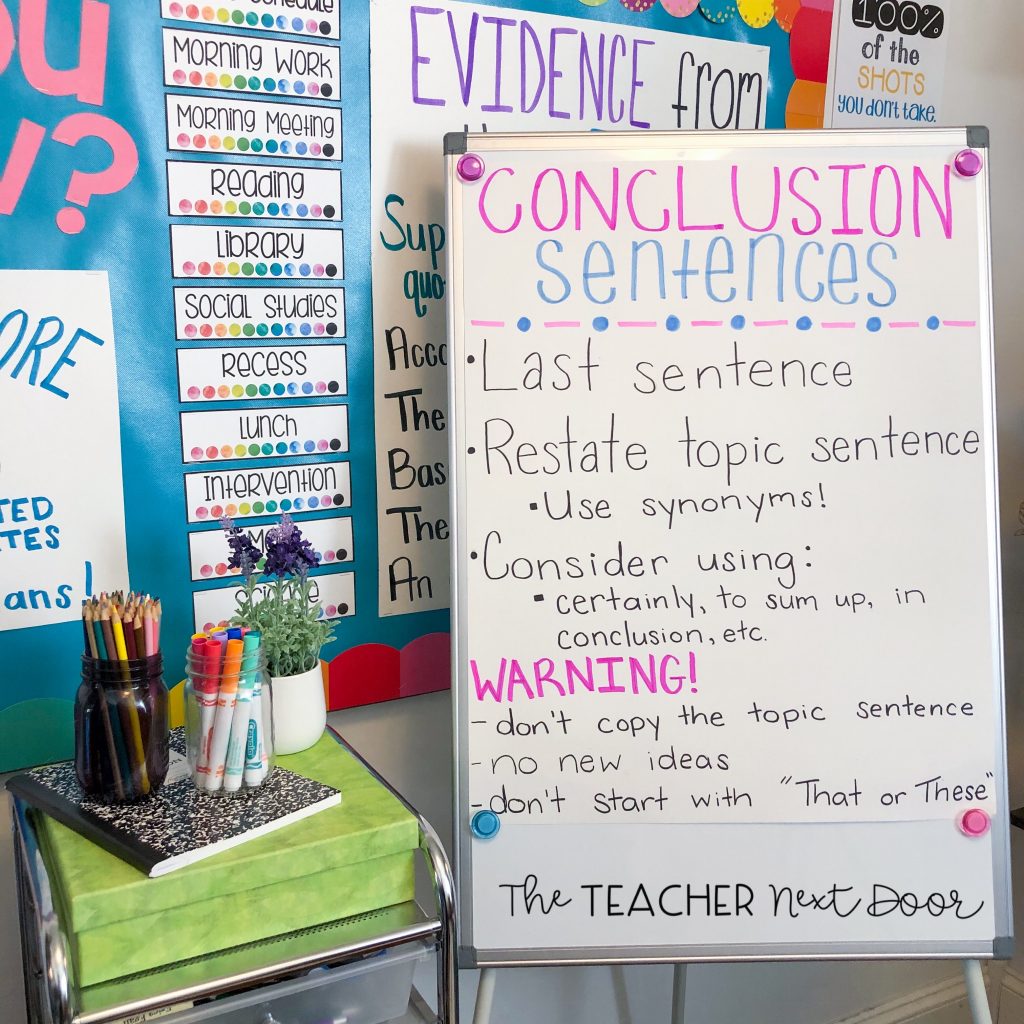
4. Make an Opinion Statement
One idea that has really helped my students write conclusions is to have them practice writing the conclusion as an opinion statement.
So, if the paragraph is about taking care of a dog, the conclusion could be an opinion statement like Dogs make great pets and are excellent companions. If the paragraph is about a Disneyland trip, the conclusion might be Disneyland is a great place to visit. For some reason, these types of conclusion sentences seem to come more naturally to students than other ones do.
5. Teach Optional Conclusion Transition Words
Teaching students a shortlist of transition words for the conclusion can also be helpful. This provides students with a way to start that last and sometimes difficult sentence.
Plus, it does provide a good signal to the reader that the paragraph is coming to a close. Some words/phrases we use include: As you can see…In conclusion…Finally…Obviously…Clearly…Certainly… I do make sure to tell students that these words are a matter of preference and NOT a must.
6. Conclusion Corrections
One last piece of advice for conclusions. Every year there is a conclusion habit that I work hard to correct. I’m not sure why so many students use these types of conclusions but to me, these conclusions make me cringe.
The weak conclusion students often fall back on starts with “That’s why…” or “Those are the reasons why…” and while I guess their teachers were just giving them a quick and easy way to end a paragraph, I just wish they had NOT given them ones that were this bad!
Sorry, but it’s a soapbox issue for me. If you teach a quick and easy way, please don’t teach a bad habit that needs to be corrected later on. So, my students know that they are not allowed to start conclusions this way and will be “dinged” if they do!
Whew…as I said, conclusions are definitely a concept that can be tough for so many students. The more we practice them though, the more they are able to rise to the occasion. I have seen a tremendous amount of growth in my students each year as writers.
Once again, you can make resources to use to help your students become better paragraph writers but if you’d like a low-prep print and a no-prep digital unit to save time, this might be the resource for you. Click here to take a look at the Complete Paragraph Writing Bundle.
If you’d like to get more teaching ideas for paragraph writing, here are a few posts you might like:
5 Tips for More Effective Paragraph Writing
Thanks so much for hanging in there with this long post!
Hope it was useful to you in some way!


